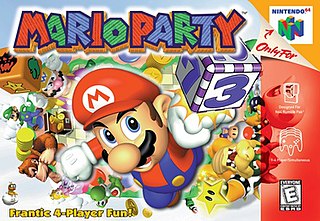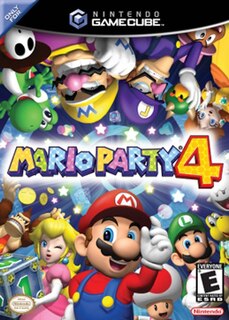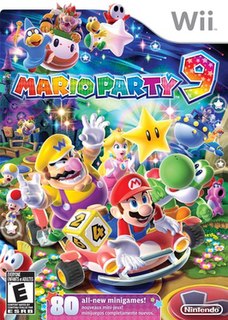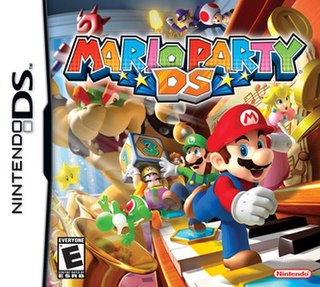 W
WMario Party Advance is a party video game developed by Hudson Soft and published by Nintendo for the Game Boy Advance. Released in 2005, it is the first handheld game in the Mario Party series, and differs from other titles in that the game is mostly single-player. Mario Party Advance was followed by Mario Party DS for the Nintendo DS in 2007, and was re-released on the Wii U Virtual Console in 2014.
 W
WMario Party is a party video game developed by Hudson Soft and published by Nintendo for the Nintendo 64 game console. It was released in Japan in December 14, 1998, in North America on February 8, 1999 and in Europe and Australia on March 9, 1999. The game was targeted at a young audience. Mario creator Shigeru Miyamoto served as development supervisor. It received mostly positive critical reviews for its multiplayer mode, concept, and music; disapproval of its slow pacing; and mixed reviews of its graphics. It is the first installment in the Mario Party series and was followed by Mario Party 2 in 1999 for the same system.
 W
WMario Party 2 is a party video game developed by Hudson Soft and published by Nintendo for the Nintendo 64. The second game in the Mario Party series, it was released in Japan on December 17, 1999, in North America on January 24, 2000, in Europe on October 12, 2000 and in Australia on November 6, 2000. the game received mostly positive reviews, who praised the improvements they made to the original, the multiplayer and minigames, but criticized the lack of originality, while graphics received a better but otherwise mixed response.
 W
WMario Party 3 is a party video game developed by Hudson Soft and published by Nintendo for the Nintendo 64. The third installment in the Mario Party series, it was first released in Japan on December 7, 2000, in North America on May 7, 2001, in Australia on September 3, 2001, and in Europe on November 16, 2001. As with the previous installments, the player chooses between eight playable characters: Mario, Luigi, Princess Peach, Yoshi, Wario, and Donkey Kong from the first two games, alongside newcomers Princess Daisy and Waluigi. The game features duel maps, where two players try to lower each other's stamina to zero using non-player characters such as Chain Chomps.
 W
WMario Party 4 is a 2002 party video game developed by Hudson Soft and published by Nintendo for the GameCube. The game is the fourth installment in the Mario Party series and is the first game in the series to be released for the GameCube. Like the previous games in the series, it features eight playable characters: Mario, Luigi, Princess Peach, Yoshi, Wario, Donkey Kong, Princess Daisy, and Waluigi from the Mario series, who can be directed as characters on 6 themed game boards. The objective is to earn as many stars as possible, which are obtained by purchase from a single predefined space on the game board. Each character's movement is determined by a roll of a die, with a roll from each player forming a single turn. Each turn is followed by a minigame in which characters compete for coins they can use to purchase items and stars.
 W
WMario Party 5 is a party video game developed by Hudson Soft and published by Nintendo for the GameCube. It is the fifth installment in the Mario Party series and the second game in the series to be released for the GameCube. It was first released in North America and Japan in November 2003, followed by Europe a month later. The game is set in the fictional Dream Depot, consisting of seven game boards. The single-player "Story" mode involves the player winning multiple games against the Koopa Kids to prevent Bowser from conquering the Dream Depot. The main multiplayer game mode consists of four characters from the Mario series playing a board game, with each board having a set theme. The game also features several minigames, which are played after every set of turns. Mario Party 5 introduces the "Super Duel" mode to the franchise, which requires players to assemble and control custom made battle vehicles which can be used in combat against other machines. The game features ten playable characters, with playable debuts to the series from Toad, Boo, and Koopa Kid.
 W
WMario Party 6 is the sixth installment in the Mario Party series of board game-style party video games by Nintendo and is the third game in the series made for the GameCube and was released in Japan on November 18, 2004; in North America on December 6, 2004; in Europe on March 18, 2005; and in Australia on September 15, 2005. It is the first GameCube game to make use of a microphone add-on. Mario Party 6 is followed by Mario Party Advance and Mario Party 7.
 W
WMario Party 7 is a party video game developed by Hudson Soft and published by Nintendo for the GameCube. The seventh main installment in the Mario Party series, it was first released in North America and Japan in November 2005, in Europe in February 2006, and in Australia in June 2006. It makes use of the microphone peripheral introduced in Mario Party 6, and features twelve characters, including two new unlockable characters: Birdo and Dry Bones. Koopa Kid was omitted as a playable character, after being playable in the two previous games.
 W
WMario Party 8 is a 2007 party video game developed by Hudson Soft and published by Nintendo for the Wii. The game is the eighth main installment in the Mario Party series, and the first title in the series released for the Wii. It was also the final home console entry to be developed by Hudson Soft, as NDcube took over development duties from Mario Party 9 onwards.
 W
WMario Party 9 is a party video game published by Nintendo for the Wii. The ninth main installment in the Mario Party series, it was announced at E3 2011 and released in Europe, North America, and Australia in March 2012, followed by Japan a month later. It was the first game in the series to be developed by NDcube, who took over development of the series from Hudson Soft, which was acquired and dissolved by Konami by March 2012. This was also the final Mario game to be published for the Wii.
 W
WMario Party 10 is a 2015 party video game. Developed by NDcube and published by Nintendo for the Wii U, it is the tenth main installment in the Mario Party series and the first game in the series since Mario Party 4 to have Donkey Kong as a playable character for every aspect of the game.
 W
WMario Party DS is a 2007 party video game published by Nintendo for the Nintendo DS. This was the last Mario Party entry to be developed by Hudson Soft, who was replaced on the franchise by NDcube in 2012. It was also released on the Virtual Console for the Wii U in April 2016. Mario Party DS was followed by Mario Party 9 for the Wii.
 W
WMario Party Superstars is a 2021 party video game developed by NDcube and published by Nintendo for the Nintendo Switch. It is the twelfth home console installment in the Mario Party series, and the second for the Nintendo Switch following Super Mario Party (2018). It was released on October 29, 2021.
 W
WMario Party: Island Tour is a party video game developed by NDcube and published by Nintendo for the Nintendo 3DS. The third handheld game in the Mario Party series, it was announced by Satoru Iwata in a Nintendo Direct presentation in April 2013, and was released in November 2013 in North America, in January 2014 in Europe and Australia, and in March 2014 in Japan. The game features seven boards, each with their own special features, and 81 new minigames. It was followed by Mario Party 10 for the Wii U in 2015.
 W
WMario Party: The Top 100, known in Japan as Mario Party 100 Minigame Collection , is a party video game developed by NDcube and published by Nintendo for the Nintendo 3DS. It is the fifth installment in the handheld series of Mario Party games and is primarily a compilation of 100 minigames from across the series. It was released first in North America in November 2017, and was released in PAL regions and in Japan in December 2017. It is the third and final Mario Party game for the Nintendo 3DS family of systems. A similar entry on the Nintendo Switch, Mario Party Superstars, was announced and released in 2021.
 W
WMario Party: Star Rush is a party video game developed by NDcube and published by Nintendo for the Nintendo 3DS. The game features a new party mode known as Toad Scramble which deviates from the normal Mario Party series in its removal of turn-based gameplay in favor of the ability to move at will, simultaneous with other players, and without set paths on the game board. The game was released in Europe, Australia, and Japan in October 2016, and in North America the following month. The game is preceded by Mario Party 10 for the Wii U.
 W
WSuper Mario Party is a party video game developed by NDcube and published by Nintendo for the Nintendo Switch. The eleventh main entry in the Mario Party series, this game was described as a "complete refresh" of the franchise, bringing back and revitalizing gameplay elements from older titles while also introducing new ones to go along with them. It was released worldwide on 5 October 2018 and sold 1.5 million copies by the end of the month. As of October 2021, the game has sold more than 16.48 million copies worldwide, making it one of the top ten best-selling games on the system. A follow up title for the Nintendo Switch, Mario Party Superstars, was announced and released in 2021.